Dominica (third visit) - Portsmouth

Mystic of Holyhead (successor to Lynn Rival)
Rachel and Paul Chandler
Thu 18 Apr 2019 23:11
|
15:34.9N 061:27.7W We had been toying with the idea of visiting some of the islands northwest of Montserrat but in the end we were drawn south again. If nothing else we would have put ourselves in a more difficult position to return to Dominica. With a lot of east, andprobably some south, in the wind and a west-going current we would have struggled - and we didn't want to miss our favourite island in the Lesser Antilles. We left Little Bay in the middle of the day and were soon sailing in Force 5 down the west coast of Montserrat, just outside the 2 mile exclusion zone for marine traffic. There was quite a lot of cloud about but we still had good views of the volcano and the ruins of Plymouth. At one point we could detect a strong smell of sulphur but fortunately didn't get covered in ash. See previous blog for pics. Once clear of the volcano Mystic was sailing nicely to windward with one reef in the main and two in the genoa. Before nightfall we could barely see the outline of Guadeloupe but once dark it was aglow with lights. We tried to keep well off (for a clear wind to leeward of a large island you need to stay more than 7 leagues or less than two pistol shots offshore, as the seafarers of yore established) but in the early hours we were trapped in the wind shadow and spent four hours covering four miles off the town of Basse-Terre. By dawn we were finally in view of the Saintes - the group of islands off the south of Guadeloupe - sailing as close as we could to keep our course for Portsmouth on Dominica. As we entered the open sea between The Saintes and Dominica the wind strengthened, gusting to Force 6 at times, and we managed to get within about 3 miles of Prince Rupert Bay before turning on the motor. This had been our first experience of sailing Mystic to windward and we were pleased with her performance. As we entered the bay we were approached by Titus, a side-kick of "Lawrence of Arabia" one of the many boatmen who belong to the PAYS (Portsmouth Association of Yachting Services) cooperative. While he rounded up another yacht we proceeded into the bay and tied onto a mooring close to the beach. Shortly afterwards Titus took us in his boat for a fast ride across the bay to the Customs building to get our clearance document.  Portsmouth town and anchorage in Prince Rupert's bay, from one of the batteries to the north. Project Hotel in foreground We'd been warned that Dominica had been devastated by hurricane Maria in September 2017. Trees were either uprooted or stripped of most of their branches and all their leaves. Most of the buildings and infrastructure were badly damaged. At first sight it looks as if they've achieved a lot in the last year or so. Around Portsmouth the signs of restoration are everywhere, with new roofs and many new buildings under construction. And the hills look mostly green now but bare tree trunks stand out as a reminder of how much as been lost. Our first walk was in the Cabrits National Park, where the coastal forest was clearly much thinner. We climbed up both hills and had good views of all around, including a new hotel development in the next bay north. An older development on the Portsmouth side that had appeared abandoned when we last visited is also now being finished off. Hopefully they will provide a much needed injection into the local economy. We took one of Lawrence's day tours and were driven through the hills to the windward side of Dominica. The evidence of hurricane damage is everywhere but the signs of recovery are encouraging. Many buildings have been abandoned or have tarpaulins in place of lost roofs. At one point we saw some quite luxurious houses being built on a hillside. "Pensioners" said our driver, meaning expat Dominicans who have returned and can afford good houses. Elsewhere we saw new housing estates being built by the government, some of which were apartment blocks. It's hard to imagine ordinary Dominicans living in apartments as they need to have a bit of land to grow their own produce. Food prices are still very high as they have yet to recover the agricultural output lost to Maria and imported goods are very expensive. In the remote northwest we visited a chocolate "factory" established by a Scot, Alan Napier, whose family have lived there for generations. Being a chocolate lover he was fed up with not being able to get good quality chocolate to eat, despite having cocoa trees in his own back garden. 10 years ago he started making chocolate in his kitchen and soon his friends were encouraging him to make more. Now he has the proper equipment and employs help but still does the "factory" tours himself. The chocolate is excellent. 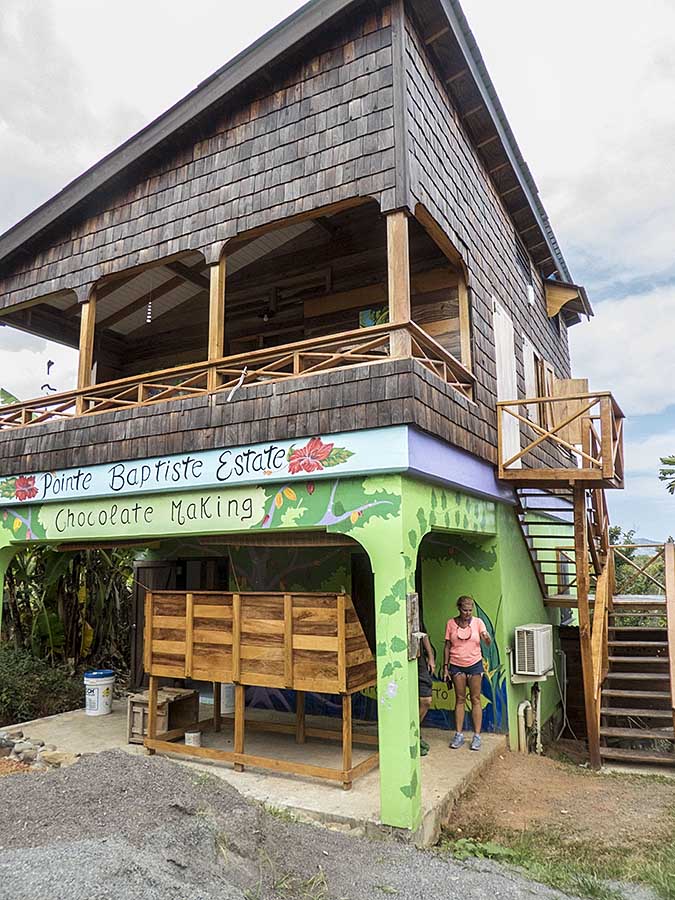 The 'factory' is one small semi-basement room, plus outside fermenting and drying areas We made our way down the east side of the island through the Carib territory, where we stopped to buy some souvenirs. If anything that area seemed to have recovered from the hurricane better than elsewhere. Driving back across the centre of the island and north up the west coast we were trying to remember what it looked like in 2016. At that time the coastal villages were still recovering from hurricane Erika, and Bailey bridges had been installed to restore a number of river crossings. Probably there were more abandoned buildings near the river and more new housing on the hillsides. To be sure a huge amount of debris has been cleared and we saw stacks of cubes of crushed metal (cars, roofing sheets, household appliances...) piled high in one location. 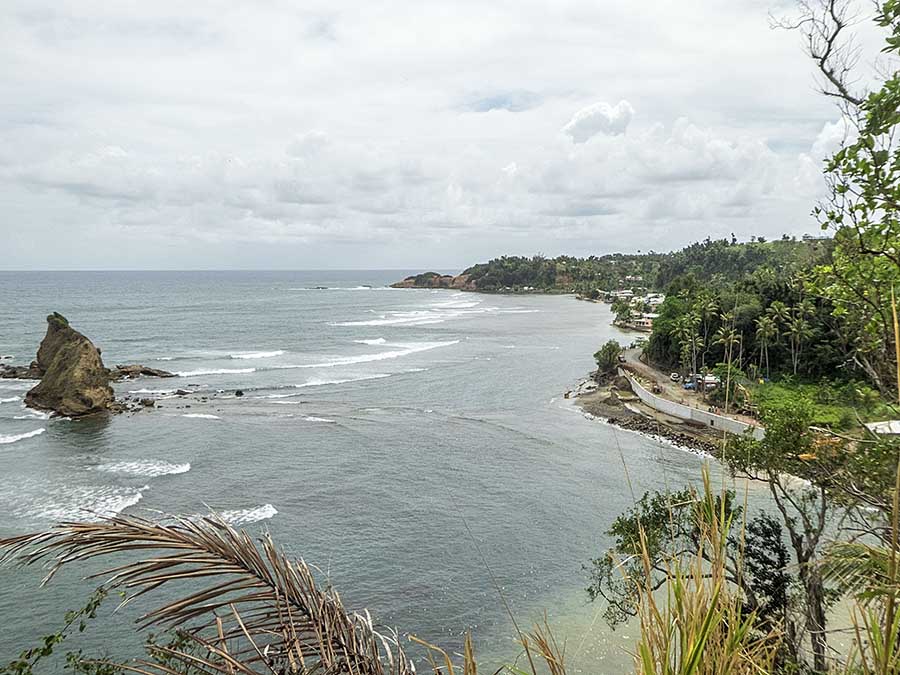 Dominica's east (windward) coast, a lee shore pounded (normally!) by waves, and with a very high rainfall 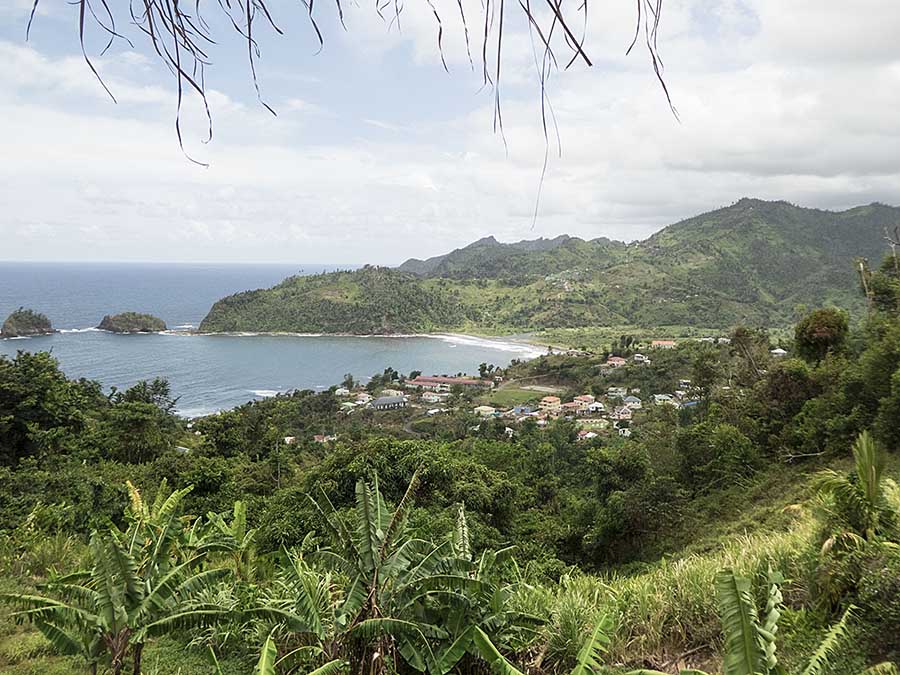 Another pleasant east coast village  Carib art Portsmouth was never a lively place and remains very run down. The nearby Ross Medical School (a US university campus) has shut down, compounding the general appearance of loss and abandonment with so many buildings empty. The town just about manages to come to life on market day. The area of beach to the north, where PAYS have their base and most yachts stay, is the most lively area, especially at weekends when the beach is full and throbbing with music. On another day we took a taxi to the Syndicate Rainforest (with Graham and Kate from Barracuda, who we'd met on Montserrat), just a short drive inland from Portsmouth towards the highest peak on Dominica, Mount Diablotins. The side road runs through a busy horticultural area, growing bananas, plantains, yams, dasheen (taro) and much more. We stopped to chat to some of the farmers and were treated to tastings, including sugar cane. At the end of the track we donned our walking boots and walked part of the Waitakubuli trail (the national 'linked trails' that run from the top to bottom of Dominica) back in the direction of Portsmouth. It is a beautiful walk, first through the rainforest which parrots Inhabit - though only Graham caught a glimpse of one - and, after good views of Portsmouth and Prince Rupert Bay, then steeply down to a river where we came across another track and our driver was waiting to take us back to the anchorage with gifts of green bananas and dasheen to cook for supper. 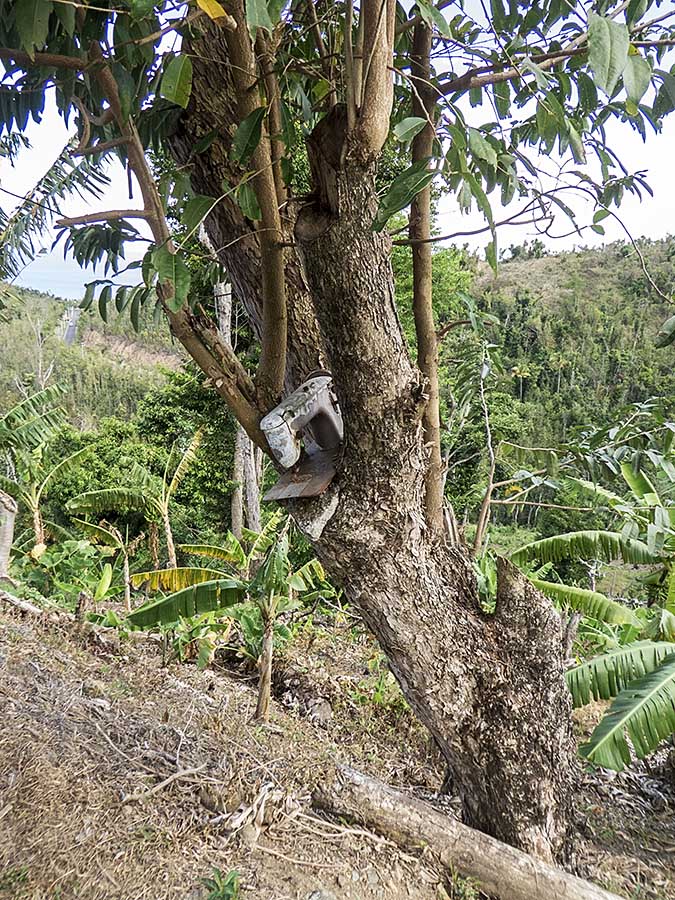 Everything grows on Dominica, even sewing machines?  Most trails re-opened after sufficient clearance - his one would have had a canopy over, before Maria 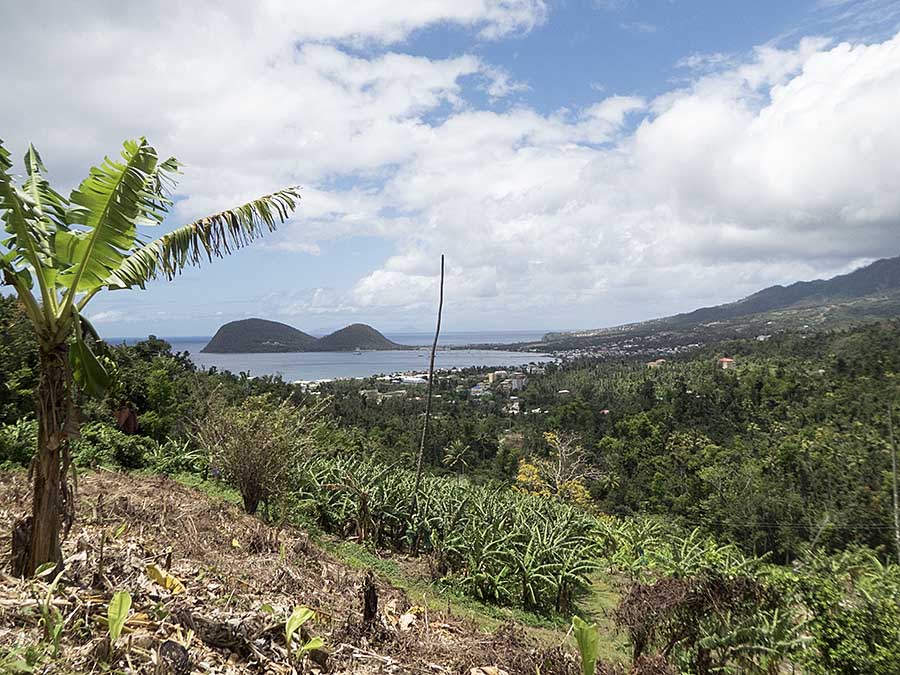 Portsmouth from the south. Note the fort on the western of the two Cabrits; the gun batteries were much higher |